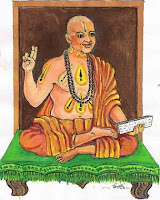One God
Amidst the confusion of belief in various gods the world over, a great reformer arose from a tribal religion of Iran. He was a priest in that religion. Being eventually disillusioned, he aspired for better knowledge. He received a vision that there was only one God. He began teaching that there was only one god and this highest God alone was worthy of worship. This reformer was none other than Zoroaster or Zarathustra. His concept of monotheism went against the polytheism of Iranian religion, but influenced monotheistic religious - Judaism, Christianity and Islam.
Judaism
Fundamental to Judaism is the belief that the people of Israel are God's chosen people who must serve as a light for other nations. The worship of "Yahweh" (God) was centered in Jerusalem. The first temple at Jerusalem was attacked by Babylonians. Jews were exiled to Egypt. Moses was born in Egypt. Yahweh Revealed himself and commanded him to become a prophet. Moses pleaded pharaoh for the release of Israelis. Moses led his people through 40 years of wandering in wilderness to reach the promised land. But he died before he could reach the promised land.
Christianity
According to Mathew and Luke, Roman emperor had ordered people of Palestine to return to the place of their family origin to be enrolled for census. Joseph and Mary had to reach Bethlehem, their family origin. Their journey from Nazareth was full of hardships. Mary was an innocent expectant mother. On reaching Bethlehem they found no place in the inn. Mary gave birth to a male child in a stable.Three wise men from a far off place came to see the child. They said "The King of Jews" is born here (That was Jesus).
Herod, the cruel emperor of Rome, became furious at the prophecy that the new born child would be the king of Jews. Joseph and Mary had to protect their child from the fury of Herod. They took the child to a safer place. Nothing is known about the child-hood of Jesus, the son of Mary.
It is said the wise men who acted on an omen to find the newborn "King of Jews" were the followers of Zarathustra, who believed in one god. By this time however Zarathushtra's followers had become dualistic, believing in gods of good and evil and incorporated the practice of astrology into their religion.
It was subsequent to the death of David. Joseph and Mary with Jesus, who was now twelve years old, traveled from Nazareth to join the feast of passover at the temple of Jerusalem. High priests and scholars at the temple then were astonished at the boy's questions and his answer to their questions.
Jesus, when thirty years old, began his teachings that has brought him many followers. His teachings were very simple - "Repent and live in the kingdom of God; Love and service to a sufferer enabled man to enter the kingdom of God".
At Nazareth where he was brought up, people could not understand from whom and where the boy of their village could learn all the big things he spoke. They bitterly opposed him. Jesus left the place and said, "A prophet is not without honor, except in his own Country, amongst his own kin and in his own house."
He triumphantly entered Jerusalem. Crowds joyfully welcomed him. Jesus was seen on the back of a donkey. According to Mathew, it was just dramatizing the prophecy of a messiah's arrival - "Lo, your king comes to you triumphant and Victorious is he, humble and riding an ass."
On entering the temple, Jesus saw a large number of merchants and money changers actively doing business with the throngs of those who had come to celebrate passover. Jesus drove them all out saying, "My house shall be called a house of prayer. But you have made it a den of robbers."
The high priests could not control their anger against Jesus. But they had to wait for a better chance to get rid of him. After the last supper the Apostates followed Jesus to a garden. Suddenly the small garden was filled with light and noise. A crowd of armed men with temple guards and men bearing torches entered the garden. Jesus was arrested and brought to the high priests. The high priests' only concern was whether Jesus claimed to be the son of God. Jesus replied, "If I tell you will not believe."
Then Jesus was taken to the Roman prefect Pontiac-Pilate. This prefect nursed a deep contempt for both the Jews and the high priests who brought Jesus to him. It has ignored all the complaints brought against Jesus by the high priests and just asked Jesus, "Are you king of Jews?"
Jesus answered, "you have said so," without responding to any other Question.
Meanwhile, Roman governor of Syria ordered Pilate back to Rome, to stand trials for crimes in office. Pilate brought Jesus to Herod Antipas, who got Jesus clothed in royal robe and encouraged his soldiers to mock the prisoner and passed the burden of decision back to Pilate. Though Pilate tried to save Jesus, he could not go against the Roman law and the opinion of the crowd.
Jesus was crucified.
Followers of Jesus not withstanding, began to spread his message to other Jews. News Came to Jerusalem from Syria that numerous Gentiles had been converted there. It was in Syria that the followers of Jesus were first called Christians. Framework of the growing missionary assumed shape over here. In spite of repressions and bloody persecutions, the churches grew in the Mediterranean World. The Roman emperor Constantin the Great was the first to become a christian emperor.
The Greek religion, which has extended its influence throughout the Mediterranean World, faded away making way for the spread of Christianity. Highly organized missionary enabled the spread of Christianity in Europe and other lands.
















